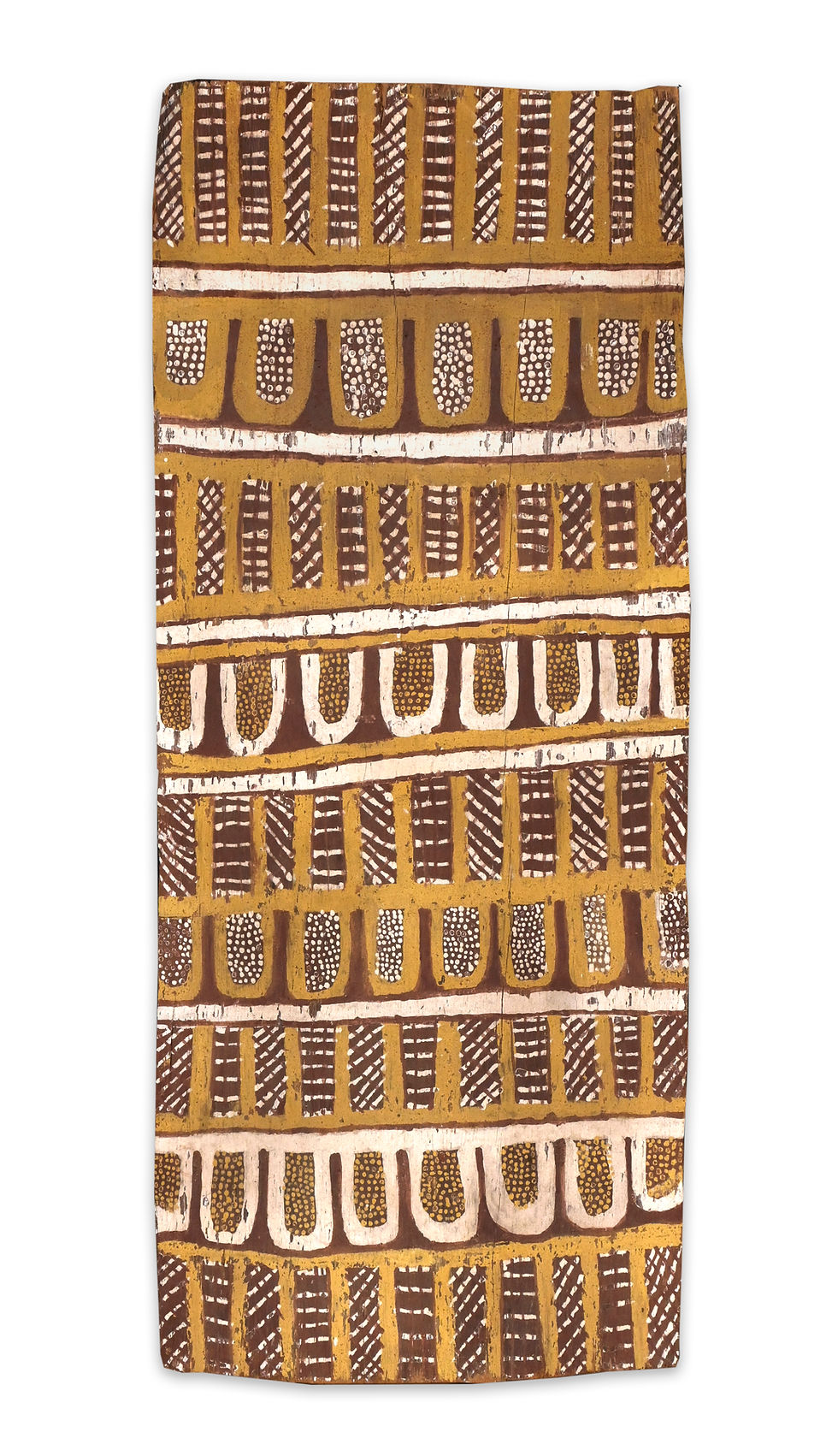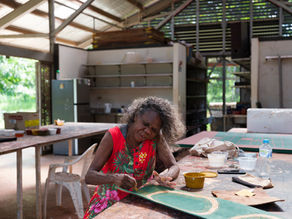FEATURED LOTS | BARK PAINTINGS
- hayley44920
- Oct 28
- 5 min read
Updated: Oct 29
FIRST NATIONS FINE ART AUCTION NOVEMBER 2025
Bark Paintings: Country Made Visible
Essay by Dr Ksenia Radchenko
When you hold a bark painting in your hands, you feel the roughness of bark, the warmth of ochre pressed into fibre, and the rhythm of a hand that worked close to the skin of a tree. The pigments breathe with the grain and curve of the bark, carrying the memory of the tree’s life. Each sheet of stringybark is peeled, cured, and rubbed smooth with stone, creating a dialogue between tree and artist that begins long before the first mark is made. The bark bends slightly as it dries, never perfectly flat, a reminder that this is a living surface, not a canvas but a skin.
As Djon Mundine writes, “until recently, bark paintings were the only Aboriginal-created object approaching ‘art’ in Western eyes. They have physical resemblances to Western painting and yet also physical differences.” That difference lies not only in form but in purpose. In Arnhem Land, artists like Yirawala painted to assert “their strong spiritual attachment to the land,” to make visible ancestral law as a defence of place. “For Aboriginal people,” Mundine writes, “art is a cultural expression, a history of a people, a statement of self-definition… a truth of history, and a statement unable to be made in any other way.” Bark painting is therefore Country made visible: the land, law, and memory.[i]
From the first collecting expeditions of Baldwin Spencer in 1912 to Tony Tuckson’s 1950s commissions for the Art Gallery of New South Wales, barks travelled a long route from ethnographic specimen to fine art. They were once “revered and yet simultaneously trivialised,” their makers unnamed even as their works hung in museums. By the 1960s, artists at Yirrkala used bark as a political instrument. The Yirrkala Church Panels (1962) and the Bark Petitions (1963) asserted ancestral sovereignty against mining on sacred land. Once read as anthropology, these works are now recognised as foundational to Australia’s political and visual history.
In recent years, bark painters have reclaimed this medium as a site of intellectual and aesthetic innovation. Exhibitions such as Yolŋu Power: The Art of Yirrkala at the Art Gallery of New South Wales, Bark Salon at the Ian Potter Centre: NGV Australia, and Madayin: Eight Decades of Aboriginal Bark Painting from Yirrkala (2023–24), which toured major museums in the United States, have shown bark painting’s evolution from the earliest commissions to its current global resonance. These exhibitions made visible what communities have always known: these works are not relics of a past world but vital expressions of continuing knowledge.

Each region gives this practice a distinct voice, yet all share the conviction that art is not an image of the world, but the world seen from within. The intricate figurative imagery of Groote Eylandt, the bold rhythmic Jilamara of the Tiwi Islands, the powerful presence
of Wandjina in the Kimberley, and the politically charged patterning of Arnhem Land all speak to the diversity and endurance of this tradition.

No region reveals the inner grammar of bark painting more completely than Arnhem Land, where the surface becomes an active field
of law and energy. Here, the rarrk, fine cross-hatched fields of white, yellow, and red ochre, is not a background pattern but a system of ancestral movement. In the hands of Kunwinjku artists, rarrk flickers like heat, delineating form while filling it with life. Arnhem Land barks often carry figures that are both anatomical and spiritual, x-ray beings whose interiors map the land itself.
Yolŋu leader Djambawa Marawili explains, “Country cannot talk to you. Luckily, the ancestors thought about it and laid their miny’tji on Country… A knowledgeable and wise person can pick up all of those parts and show exactly how they are connected.”[ii] Through miny’tji, the sacred designs describing water currents, tides, lightning, and wind, Country finds a tongue. Bark is its breath. Artists of Arnhem land extend bark’s reach beyond ceremony into the global sphere while remaining grounded in the ethics of gurrutu, the Yolŋu kinship system connecting all beings. Some now work on metal or acetate, or use bright acrylic pigments, yet their practice remains bark-born, translating the pulse of Country into new material languages.
Across the water, the Tiwi Islands express their world through Jilamara, or design. Here, the language of painting is rhythmic and abstract rather than figurative. As Anna Hart notes, Jilamara painted on bark, body, or Tutini (funerary poles) enacts remembrance and ceremony: visual patterns that connect the living and the dead.[iii] The Tiwi palette: red, yellow, and white ochre, is applied with a Kayimwagakimi comb to create pulsating fields of pattern. The power of Tiwi painting lies in its restraint: there are no figures, only rhythm and structure. This visual language, pre-dating Western abstraction, transforms repetition into philosophy.

On Groote Eylandt, bark painting developed a distinctive aesthetic that remains instantly recognisable: a balance of formal precision and spiritual resonance. Groote Eylandt barks are defined by their strong black grounds, against which figures and abstract motifs emerge in vivid red, white, and yellow. Outlined in yellow and filled with parallel or cross-hatched lines, these images, turtles, squids, birds, Macassan praus, and constellations, are not simply decorative but charged with totemic and ancestral meaning. Their visual order and rhythmic clarity reveal what Frederick Rose once called the “aesthetic and magical” motive of this art: compositions that refine rock art conventions into an intentional, formal language.[iv]

In the far northwest, the Wandjina of the Kimberley appear in chalk-white forms edged with ochre, their wide eyes and closed mouths radiating presence. Ian Crawford described them as “faces of the rain,” beings whose visibility ensures renewal. As Margo Neale observed, their power endures through adaptation: migrating from ro
ck to board to canvas without losing authority.[v] The Wandjina do not speak; they look. Their silence is an active force, their gaze returning that of the viewer. Painting here is both image and invocation, an act of care for Country and weather alike.
Rather than a precursor to later painting movements, bark painting continues alongside them, evolving and carrying forward ancestral authority. It sustains connections across time and geography, revealing the depth and continuity of cultural practice across northern Australia. As Kupka once called Australian First Nations art “the dawn of art,” his phrase fails to grasp bark’s contemporaneity, an art that never ceased evolving. Mundine reminds us that “Aboriginal people have used our diverse expression and forms to make ourselves visible as the audience for our art grows, and yet paradoxically we appear increasingly invisible.”[vi] Bark painting continues to counter that invisibility. It is an art that holds both the mark of the hand and the weight of thought, where pigment, surface, and story remain inseparable.
1 John Mundine, “An Aboriginal Soliloquy,” in They Are Meditating: Bark Paintings from the MCA’s Arnott’s Collection, ed. John Mundine et al. (Sydney: Museum of Contemporary Art Australia, 2008), 15.
2 Yolŋu Power: The Art of Yirrkala, ed. Cara Pinchbeck (Sydney: Art Gallery of New South Wales, 2025), 23
3 Anna Hart, “Body, Design, and Memory in Tiwi Jilamara,” Art Monthly Australasia, no. 256 (2012): 24–28.
4 Lindy Allen, “The Aesthetic and Magical: Groote Eylandt Bark Painting,” in They Are Meditating: Bark Paintings from the MCA’s Arnott’s Collection, ed. John Mundine et al. (Sydney: Museum of Contemporary Art Australia, 2008), 70–75.
5 Margo Neale, “Continuity and Change: The Wandjina in Contemporary Art,” Artlink 26, no. 2 (2006): 52–57, 53.
6 Mundine, “An Aboriginal Soliloquy,” 31.









